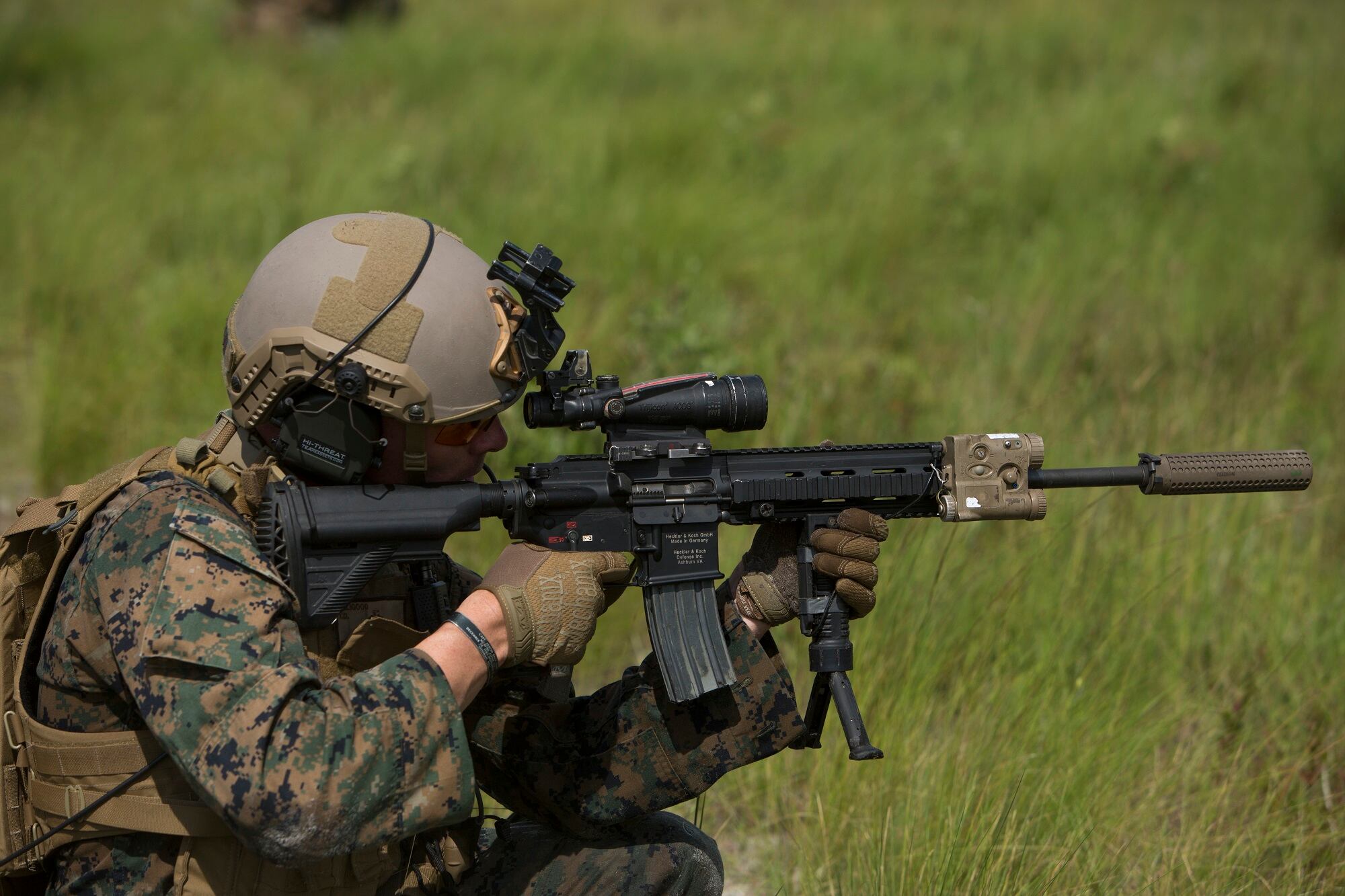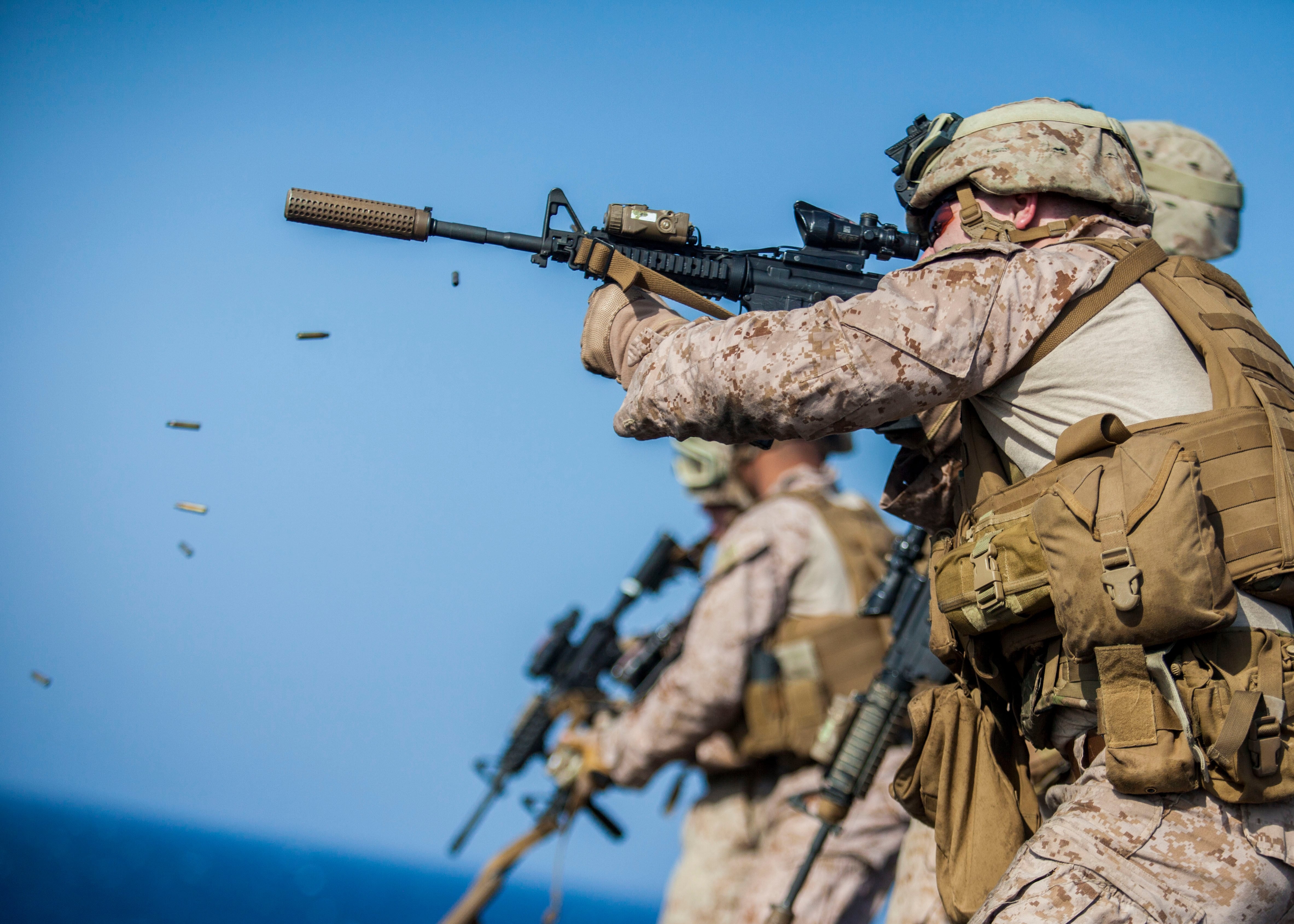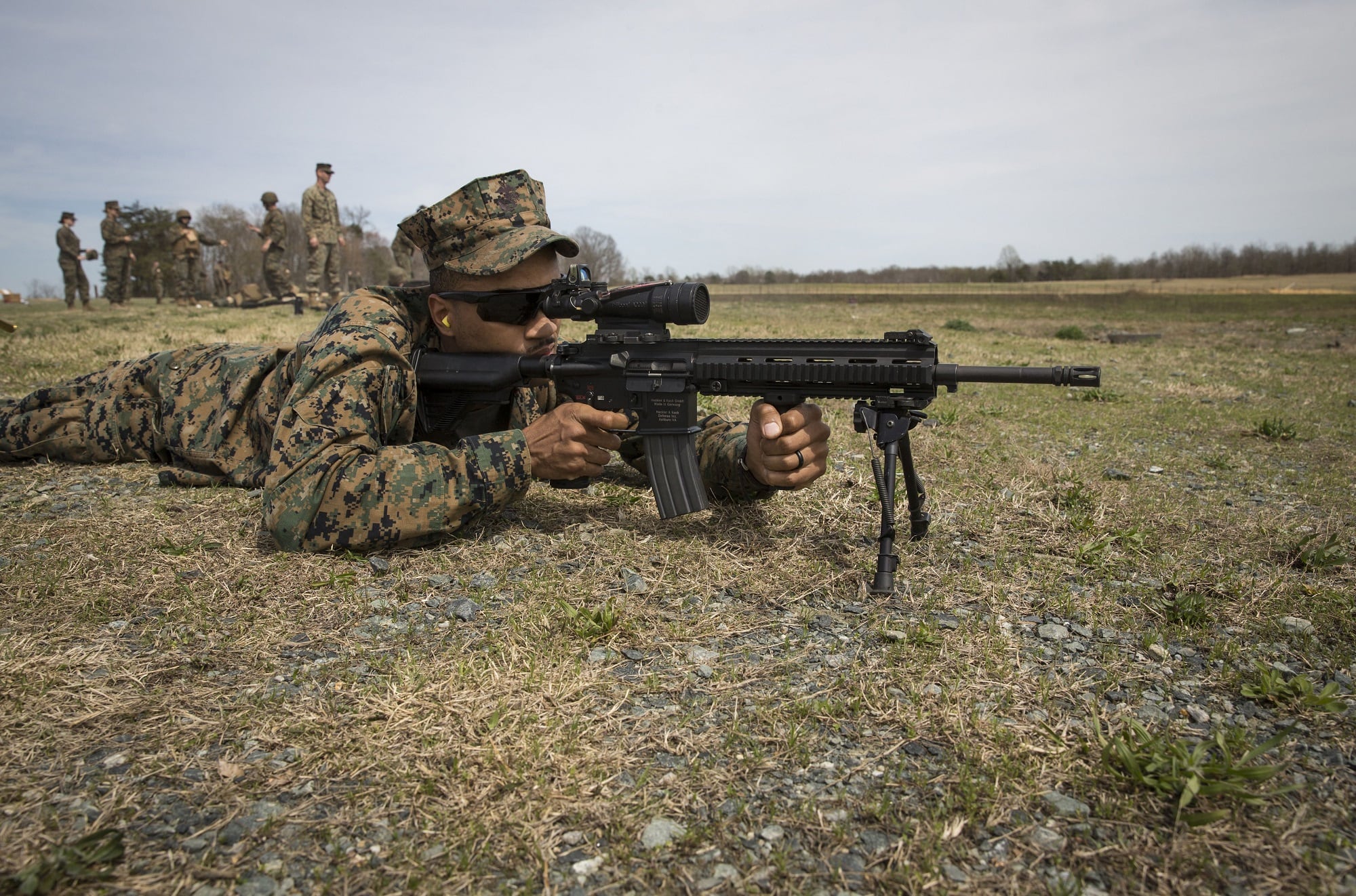The Marine Corps is investing millions of dollars for new equipment to make infantry squads more lethal than ever.
Now, senior leaders are also talking about a fundamental reorganization of the rifle squad to put older and more seasoned noncommissioned officers in charge of those expanding capabilities.
Plans under discussion would require infantry squad leaders be staff sergeants, who might have eight to 10 years of experience, rather today’s sergeants and corporals who might still be at the end of their first term of enlistment.
The proposal also calls for creating a new position of “assistant squad leader,” which would be a sergeant who is second in command and will focus on technology, according to Marine Corps officials familiar with the proposal.
That would amount to the biggest change in the structure of Marine rifle squads since the Second World War. It could have far-reaching impacts on the Marine Corps’ culture, force structure, career paths and ground-level operations.
The idea of having staff noncommissioned officers fill squad leader billets reflects the Marine Corps’ desire to have more mature, experienced Marines lead increasingly lethal rifle squads.
“The complexity of the battlefield and the operating environment today is so much more complex than it was for me in the Gulf War or Somalia,” said 2nd Marine Division Gunner, CWO 5 Christian Wade, a longtime Marine who is leading an experiment with reorganized squads.
“With the information environment, with technologies, with connectiveness — we have essentially taken combat responsibilities and pushed them one level lower than when I was a young sergeant,” Wade said.
For decades, Marine sergeants have typically served as squad leaders, but lower ranking Marines often fill the position when there aren’t enough sergeants for the job.
Wade noted that while the demands on squad leaders have grown over the past 30 years, the time it takes Marines to get promoted has shortened by years.
When Wade entered the Marine Corps in the 1980s, he said, it typically took Marines an average of seven or eight years to make sergeant, he said. Now that the Corps’ promotion scale is aligned with the rest of the Defense Department, Marines can be promoted to sergeant after four years and staff sergeant after eight years.
“The rifle squad leader is — in my opinion — the most important Marine in the Marine Corps,” Wade said. “He is the leader of our base unit around which the rest of the Marine Corps revolves. The success of that squad is directly dependent on his credibility, his maturity, his experience, his decision-making and his skill and will.”

Information overload
Today’s rifle squads are getting more gear than ever before. The Corps is buying thousands of powerful M27s to replace M4s. And more Marines are getting suppressors for their weapons.
Gear in the testing phase includes new squad-level drones, anti-tank missiles and laser range-finders that could allow Marines to call in artillery or airstrikes without having a joint terminal attack controller on the ground.
Marine officers are worried that today’s squad leaders are confronted with far more information, intelligence and communications equipment than ever before.
Lt. Col. Daniel Wittnam, who heads the ground combat element for the Marines’ Plans, Policies and Operations office, framed the question as an across-the-Corps talent management problem.
“How much information can one person process?” Wittnam said at the annual Modern Day Marine military expo in Quantico, Virginia, in September.
“How do we shape the force to not overload the assistant squad leader or squad leader?” he told a crowd of attendees at the expo.
Wittnam said the assistant squad leader position would function like a chief technical officer for the squad, coordinating and pushing capabilities to the squad leader.
RELATED

The Corps is testing the new rifle squad structure with the “Übersquad” from 1st Battalion, 6th Marines, which is experimenting with many ideas that the Corps’ top brass is considering for the entire infantry force, including special operations gear, fully automatic rifles and suppressors.
Wade is overseeing the Übersquad and right now, he is looking for a staff sergeant to serve as squad leader, he said.
He wants a Marine about 25 years old because that’s the age when the human brain is fully formed, he said. If his idea is approved, the staff sergeant could lead the Übersquad in the next month or two.
He wants to “take what we now call and think of conceptually as a staff sergeant, who has been through the Infantry Unit Leader’s Course — that’s the guy I want to put in charge of my Übersquad,” Wade said.
“That Marine that I’m looking for is a staff sergeant. But in relative terms, he’s what during the ’80s we would have considered a sergeant because of time and maturity.”
For the Marine Corps, the current structure that saddles young Marines with big responsibilities is a source of pride. In the Army, on the other hand, staff sergeants are already serving as squad leaders and sergeants serve as team leaders.
Special operations forces teams also often have more seasoned leaders with higher rank.
Stuck at the squad level?
The move would likely be unpopular among many Marines, who may view it as questioning their competence or as essentially a demotion for sergeants. An online survey of more than 400 Marine Corps Times readers found that four out of five respondents believe the current structure should remain unchanged.
Morale may suffer if infantry Marines are forced to remain at the squad level for more than 10 years, said retired Sgt. Maj. James Booker, a Silver Star and Bronze Star recipient.
“That’s a lot of time in the grunts right there, to only be at the squad level,” said Booker. “At some point in time, you’re like: ‘Hey, man; how many years can you stay at the squad level?’ Just wear you out.”
And there may be secondary effects.
Typically, staff sergeants work for lieutenants as platoon sergeants, Booker said. If staff sergeants became squad leaders, it might bump all positions up a rank — gunnery sergeants might have to serve as platoon sergeants, etc., he said.
Booker retired in July 2015 after spending 32 years in the Marine Corps. From July 2013 to December 2014, he served as the senior enlisted adviser to now Chairman of the Joint Chiefs of Staff Gen. Joseph Dunford, who was commander of U.S. and NATO troops in Afghanistan at the time.
For the Marine Corps at large, it would take a tremendous increase in the number of staff noncommissioned officers to have enough staff sergeants to lead all infantry squads, and that would make it more difficult for staff sergeants to get promoted, Booker said.
“I hope they can do it, but it sounds to me like a bridge too far,” Booker said.
No proof exists that the Army’s model for squad leaders is better than the Marine Corps’, said retired Marine Sgt. Maj. Bryan Battaglia.
“In my research, I have found no evidence or data that an Army squad led by a staff sergeant successfully accomplished more missions, eliminated more enemy threats, and took less casualties than that of any Marine rifle squad led by a sergeant,” said Battaglia, who served as senior enlisted adviser to the chairman of the Joint Chiefs of Staff from 2011 to 2015.
“But, evidence does show that our infantry squad leaders in contested and uncontested environments can become overwhelmed. That said, I do believe there is a need to better equip the infantry squad leader.”
Retention challenges
Putting staff sergeants in charge of infantry squads would require the Marine Corps to retain more than 600 additional Marines at the E-6 paygrade.
That would cost a lot of money, and have ripple effects across the personnel system.
“The issue is whether the Marine manpower structure can generate more staff sergeants and whether the culture of the infantry squad can adapt to such a major change,” said Marine veteran Bing West, who has authored eight books about Marines in three wars: Vietnam, Iraq and Afghanistan.
The Marine Corps’ current manpower model cannot produce enough staff sergeants to lead all rifle squads.
Yet the Corps can find solutions if it thinks creatively, Wade said.
“If the Marine Corps is going to put its money where its mouth is, it should invest more in the rifle squad leader,” Wade said.
Even if the Corps opts against requiring all squad leaders to be staff sergeants, there are other ways to elevate the position of squad leader beyond that of a typical E-5, for example by paying them more and giving those Marines distinct insignia to wear on their uniform, Wade said.
“I’m willing to put a device on this guy that designates him or her as rifle squad leader,” Wade said.
“I’m willing to pay them more. In fact, I wouldn’t mind going out and recruiting these people. The special operations community gets to do all of those things: They put devices on their people; they recruit them; they retain them in a different way and they pay them more money.”
There may be strong logic to elevating squad leaders to the staff sergeant level, but that comes with a lot of manpower and retention challenges, said Katherine Kidder, a military personnel expert with the Center for a New American Security think tank in Washington.
“I’ve seen arguments out there that the pace of warfare and the pace of technological change is ramping up at such a rate that you would want the wisdom and the judgment of a more senior squad leader to make these rapid-fire decisions with more powerful weapons that have more lethality,” Kidder said.
But, she said, “I also don’t know that the manpower system is set up to support that currently.”
Changing the structure of rifle squads would put a new spotlight on retention.
The Marine Corps is seeing an uptick in staff sergeants and gunnery sergeants leaving after 12 or 14 years of service instead of retiring at 20 years.
In fiscal 2016, the Corps saw a 2 percent drop in the number of staff sergeants it retained and a 4.5 percent drop for gunnery sergeants compared to the four-year average.
“We are losing people at the 12-year mark — or the mid-career mark — when we would need their wisdom and experience to be the squad leaders,” Kidder said.
With more staff noncommissioned officers leaving the Corps, Marines will be promoted faster, Sergeant Major of the Marine Corps Ronald Green told Marine Corps Times earlier this year.
“That means your leadership is going to be younger with less experience,” Green said in a July 24 interview. “We want to mature the force and make sure that Marines spend enough time at their [current] rank and receive the reps that it takes to have that good experience and be ready to move to the next level.”
Recon Marines
Older and more seasoned squad leaders are a better fit for Reconnaissance Marines than infantry units, said Gunnery Sgt. Shawn Talbert, with 3rd Reconnaissance Battalion in Okinawa, Japan.
Talbert said he served as a squad leader when he was a lance corporal, but leading reconnaissance Marines requires a totally different set of skills compared to leading riflemen and machine gunners.
“It takes years to develop a reconnaissance Marine, with the full capabilities of jump, dive, freefall, as well as the master courses and supplemental courses, like sniper school and [Joint Terminal Attack Controller],” Talbert told Marine Corps Times.
“With the ops tempo that we have in training and our deployment cycle, you’re not going to get that right away. It’s going to take about a good eight to ten years to get that guy where he needs to be to actually be a reconnaissance team leader or reconnaissance course team leader.”
Brain science
Science has shown that older troops are more likely to survive close combat than younger service members, said retired Army Maj. Gen. Robert Scales, author of “Scales on War: The Future of America’s Military at Risk.”
Casualty statistics from past wars have shown that younger troops tend to be most likely to rush the enemy without enough preparation or reflexive thought — and are more likely to die, Scales said.
One reason is the prefrontal cortex of the human brain, which controls reasoning, learning and self-control, matures much slower than the part of the brain that controls reflexive actions, he said.
“A fully developed cortex doesn’t arrive until the late twenties,” Scales said. “Thus, we find that very young men, those with an immature and undeveloped cortex, tend to be impetuous, lack self-control and tend to seek danger.”
In combat, troops need to use, stealth, deception and guile to find weaknesses in an enemy’s position and then exploit it with fire, he said. This requires patience and caution, not impetuosity or reflexive behavior.
Infantry Marines are often teenagers, while members of U.S. special operations forces are typically at least 10 years older, Scales said. The age difference is one reason why special operations forces tend to suffer far fewer deaths than Marines, even though they may fight more dangerous engagements.
648 new staff sergeants
The idea of having more seasoned rifle squads is not new. In 2005, then Marine Corps Commandant Gen. Michael Hagee approved the “distributed operations” warfighting concept, which called for making sure that all rifle squad leaders were sergeants with between five and seven years of service.
CNA, a research institution funded by the Defense Department, issued a 2007 paper that concluded, “It may make more sense to have staff sergeants, rather than sergeants, as the [distributed operations]-qualified infantry rifle squad leaders.”
RELATED

Having staff sergeants serve as rifle squad leaders would require fewer changes to the Corps’ manpower system than ensuring that sergeants had enough experience to fill rifle squad leader billets, according to the CNA paper.
“If all infantry rifle squad leaders were required to be staff sergeants (vice sergeants), the problems of experience and qualifications at the time in their careers when they would serve in these billets should not be a problem,” the paper says.
“A staff sergeant would have served his first term in the operational forces, probably had a B-billet tour in the support establishment, and then would be ready to go back to the operational forces.”
The paper’s authors calculated it would take 648 staff sergeants to lead all the rifle squads in the Corps’ 24 active-duty battalions.
However, staff sergeants earn more in salary than sergeants, so having them serve as squad leaders would cost the Marine Corps more money, the paper found. The Marine Corps would also have to create a promotion pipeline to ensure it had enough staff sergeants to fill squad leader billets and serve in the other roles required by Marines of that rank.
The next fight
All Marines will have to be stronger and smarter to fight future adversaries, but squad leaders in particular will be asked to do more, Corps officials have said.
Squad leaders’ will need to counter enemy drones, electronic jamming and information warfare in the middle of a fight — all while running the squad, said officials with the Ellis Group, the Marine Corps’ internal think tank that explores future warfighting scenarios.
When Marines face a near-peer adversary, the squad leader will be “the busiest person on the battlefield,” Doug King, director of the Ellis Group, said in August 2016.
“We need to make sure that’s the right person and they’re trained properly and they have enough resources,” King said at the time.
Todd South and Andrea Scott contributed to this report.




